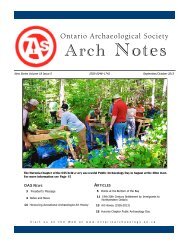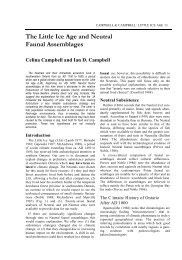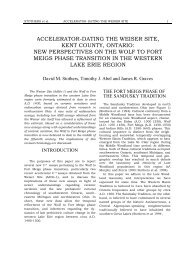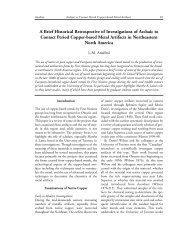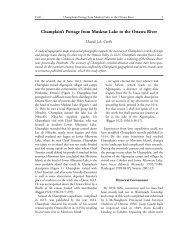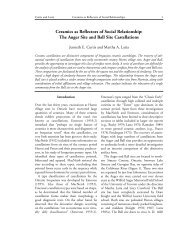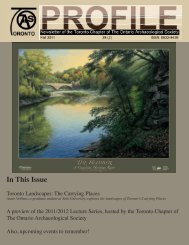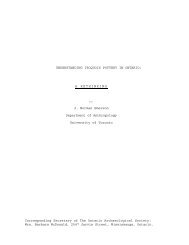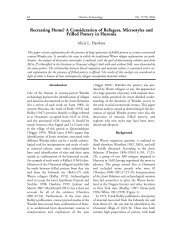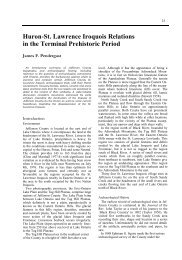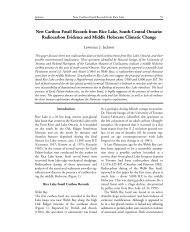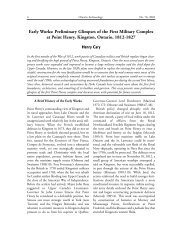A Hillside Midden, King s Forest Park Site - Ontario Archaeological ...
A Hillside Midden, King s Forest Park Site - Ontario Archaeological ...
A Hillside Midden, King s Forest Park Site - Ontario Archaeological ...
You also want an ePaper? Increase the reach of your titles
YUMPU automatically turns print PDFs into web optimized ePapers that Google loves.
18 ONTARIO ARCHAEOLOGY No. 10WILLIAM A. Fox(Accepted February 17th, 1967)A <strong>Hillside</strong> <strong>Midden</strong>,<strong>King</strong> ' s <strong>Forest</strong> <strong>Park</strong> <strong>Site</strong>ABSTRACTThis report lists the finds made in an excavation of a midden on the<strong>King</strong>'s <strong>Forest</strong> <strong>Park</strong> site subsequent to the Society ' s excavation carried out inthe spring of 1963.INTRODUCTIONReports of an area of disturbed, blackened earth containing pot sherds,located on the south side of the north playing field of Rosedale <strong>Park</strong> led tothe discovery of the second midden to be recorded on the <strong>King</strong>'s <strong>Forest</strong> <strong>Park</strong><strong>Site</strong>, Hamilton, <strong>Ontario</strong>. The midden was located at the edge of a woodlotand seems to have escaped extensive disturbance through Europeancultivation for this reason. Previously, one midden and eleven hearths hadbeen excavated.E X C A V A T I O NWhen the reported location was first checked in September, 1965, itwas found that the midden was disturbed generally in the northern half andin a few places in the southern half.A test trench revealed that part of the midden was still undisturbedand a five-foot test-square was then excavated in what was believed to bethe richest part of the midden. Some artifacts were obtained and the wallsshowed four profiles of the refuse accumulation. Since an east-west crosssectionof the midden was desired to give the midden profile in Figure 1,excavation of a series of 30 in. squares was begun. The work was soonhalted by winter.In March, 1966, the excavation of 30 in. squares was continued in allfour directions to determine the extent of the midden, to gain more profilesand to obtain more analysable artifacts. A total of 137.5 sq. ft. of the refusedeposit was excavated which measured approximately 26 (N-S) by 17 (E-W)ft. No stratigraphic change was noted in the midden material, sherds fromthe top and bottom of the deposit often belonging to the same vessel.FOOD REMAINSShell fragments of the painted turtle (Chrysemys picta) and fish bonespredominated in the midden remains. Among the fish represented in themidden deposit were speckled trout (Salvelinus fontalis), bowfin
FOX: HILLSIDE MIDDEN 19E—W CROSS—SECTION LOOKING N.FIGURE I(Amia calva), brown bullhead (Ictalurus nebulosus). and possibly thefreshwater drum (Aplodnotus grunniens).The only large mammals represented in the remains are the black bear(Ursus americunus) and the white-tail deer (Odocoileus virginianus). Bonesof the grey squirrel (Sciurus carolinensis) were by far the most common ofthe mammalian remains, but a few beaver (Castor canadensis) andwoodchuck (Marmota monax) were also present.Among the bird remains, bones of the passenger pigeon (Ectopistesmigratorius) were the most common, but one blue-winged teal bone (Anusdiscord was identified, and some turkey bones (Meleagris gallopavo),bleached from exposure, may be of the same age as the midden. Theremaining avian bones were from rails (Rullidae) and various species ofducks (Anas spp.) .A single bone from a snapping turtle (Chelydra serpentina) and onefrog vertebra were recovered, together with a number of freshwater clamshells.WORKED BONEARTIFACTSBone artifacts comprised three split bone awls, one fish spine awl, partsof five other bone awls, three possible pottery decorators, one flesher, onecrude bone bead, one piece of worked turtle shell, a slightly worn fragment ofbeaver incisor and the top of a possible three tooth comb.Two of the complete split bone awls are notable for their fine workmanship.One has a fine, needle-like point, while the other (Fig . 2) has beencarefully worked all over and has an incised geometric design at its base.The three pottery decorators consist of bone fragments with the sharpends slightly smoothed.The flesher is a blade of bone whose sharp edges are rounded from use.
20 ONTARIO ARCHAEOLOGY N o . 10FIGURES 2 - 21 — Drawings of stone, bone and pottery artifactsFigures 2 and 3 — Bone artifactsFigures 4 - 14 — Stone artifactsFigures 15 - 18 — Cross-sections of pipe stems
FOX: HILLSIDE MIDDEN 21from the <strong>Hillside</strong> <strong>Midden</strong>, <strong>King</strong> ' s <strong>Forest</strong> <strong>Park</strong> <strong>Site</strong>.Figure 19 — Lateral outline of clay pipeFigure 20 — Detail of fragmentary clay effigy pipe bowlFigure 21 Half-section of clay vessel
24 ONTARIO ARCHAEOLOGY N o . 10
FOX: HILLSIDE MIDDEN 25fled and ribbed paddle malleated. The body sherd seriation is recorded onTable 1. Six body sherds were unidentifiable because the exterior surfacehad split off.The largest vessel reconstructed showed the body shape to be quitesimilar to that of several more completely restored vessels from theWoodman site. The profile of a finely made vessel from the Woodman site isillustrated in Figure 21.NECK SHERDSTwo hundred and sixty-five neck sherds were recovered and are seriatedin Table 2. What may be black paint adheres to the surface of two smoothedovercord sherds.RIM SHERDSA seriation of the one hundred and twelve rim sherds recovered isrecorded on Table 3. Of the seven decorated sherds from juvenile vessels, sixcould be identified using Wright's (1966) typology and are included in Table3. Two rim sherds were Middleport Criss-Cross, two were Woods-menCorded, one was Goessens Punctate, one was Stafford Stamped. The seventhsherd still retained finger marks and had two parallel rows of vertical linearstamp along one edge. Table 4 is a seriation of rim sherd bossing.CASTELLATIONSThere were two varieties: incipient pointed and incipient rounded. Thenumbers in brackets following each vessel type represent the number ofcastellations found per vessel. Incipient pointed castellations occurred onone <strong>Ontario</strong> Oblique vessel (1), one Stafford Dentate vessel (1), oneMiddleport Criss-Cross vessel ( 2 ) and one Scugog Classic Bossed vessel (1).Incipient rounded castellations were found on two <strong>Ontario</strong> Oblique vessels(1), one <strong>Ontario</strong> Horizontal vessel ( 4 ) and one Stafford Stamped vessel (1).One channelled castellation from a Stafford Dentate vessel had a brokenpeak and could not be classified. The Scugog Classic Bossed vesselcastellation was channelled and was bolder than usual. The MiddleportCriss-Cross vessel which was castellated, is the afore-mentioned juvenilevessel of this type, and one Woodsmen Corded juvenile vessel rim sherdrepresented one half of a castellation. No vessels combined incipient pointedand incipient rounded castellations.MISCELLANEOUSTwo <strong>Ontario</strong> Oblique vessels had been drilled. Two holes were drillednear the rim of one ; one either side of a vertical crack. Carbonized food wasfound adhering to the exterior surface of this vessel in the vicinity of thevertical crack. Apparently, the cracked vessel was held together by a thongor twine.A half-round fillet was added to the upper face of an <strong>Ontario</strong> Obliquevessel rim and a clay slip covered part of the decoration of an <strong>Ontario</strong>Oblique rim sherd.The clay needed for the pottery possibly was obtained from the creekbank at the north end of the site, where there is a deposit of the
26 ONTARIO ARCHAEOLOGY No. 10grey clay which is found fired in refuse deposits on the nearby Woodman siteof a similar age.TABLE 3R I M SHERD SERIATIONf %<strong>Ontario</strong> Oblique ---------------------------------------------------------------- 46 41.1Glen Meyer Oblique ----------------------------------------------------------------Middleport Criss-Cross ------------------------------------------------------------- 7 6.2Stafford Stamped ---------------------------------------------------------------- 2 1.8Ripley Plain ---------------------------------------------------------------- 6 5.4Woodsmen Corded ---------------------------------------------------------------- 3 2.7Glen Meyer Linear Stamped ----------------------------------------------- 11 9.8Goessens Punctate ---------------------------------------------------------------- 4 3.6Glen Meyer Necked ---------------------------------------------------------------- 9 8.0Goessens Necked ----------------------------------------------------------------Goessens Oblique ---------------------------------------------------------------- 1 0.9Stafford Dentate ---------------------------------------------------------------- 12 10.7<strong>Ontario</strong> Horizontal ---------------------------------------------------------------- 9 8.0Iroquois Linear ----------------------------------------------------------------Scugog Classic Bossed -------------------------------------------------------------- 2 1.8Total --------------------------------------------------------------------------------- 112 100CONCLUSIONSince only one midden is represented in this report, the materialreported represents an incomplete, but probably pure assemblage of theartifacts used by a Southern <strong>Ontario</strong> Indian group.<strong>Ontario</strong> Oblique, Middleport Criss-Cross and Ripley Plain rim typescomprised 52.7 % of the midden rim sherds. This rim type percentage isused by Wright (1966) to confirm his chronology of four Glen Meyer branchsites and seems to indicate that the midden material is of a mid-Glen Meyercultural provenance by Wright's chronology.The presence of rim types common to both Glen Meyer and Pickeringbranch sites, such as: <strong>Ontario</strong> Oblique, Ripley Plain and variations onStafford Dentate, and the presence of <strong>Ontario</strong> Horizontal and Scugog ClassicBossed rim types which are noted only on Pickering branch sites, indicatethat there was probably contact between the people of the <strong>King</strong>'s <strong>Forest</strong> <strong>Park</strong>site and the Pickering branch. It is interesting to note that a major GlenMeyer branch rim type, Glen Meyer Oblique, is absent from the middenassemblage.
FOX: HILLSIDE MIDDEN 27
28 ONTARIO ARCHAEOLOGY No. 10The food remains point to a summer and fall occupation of the site. Ittherefore seems that the <strong>King</strong>'s <strong>Forest</strong> <strong>Park</strong> site was only occupiedseasonally, which is in agreement with the finding of the 1965 report on thesite.In summary, it can be said that at least one family of the Glen Meyerpeople, at some time close to 1200 A.D. (Wright, 1966), made their summerand fall home on the site area. They probably lived a less than comfortableexistence through practicing some agriculture augmented by small gamehunting and fishing. The fish represented in the midden could be caught innearby Albion Creek and at its mouth where a marsh probably existed as itdoes today. Their main small game, the grey squirrel, was no doubt found inthe vicinity of the site.ACKNOWLEDGEMENTSThe publication of this article was only made possible through thegenerous aid of several individuals. Dr. J. N. Emerson and Dr. C. S.Churcher both gave valuable suggestions as to the form of this report. Dr. H.Savage and Dr. Bouliane kindly identified the animal and fish bonesrespectively. The turtle bone was sorted by Mr. J. Reid.REFERENCESDonaldson, W. S., 1962. The Thomas <strong>Site</strong>. <strong>Ontario</strong> Archaeol. No. 7, Ser. B,No. 2, 21-38.- 1 9 6 5 . The <strong>King</strong>'s <strong>Forest</strong> <strong>Park</strong> <strong>Site</strong>. <strong>Ontario</strong> Archaeol. No. 8, Ser. B,No. 3, 3-10.MacNeish, R. S., 1952. Iroquois Pottery Types: A Technique for the Study ofIroquois Prehistory. Nat. Mus. Canada, Bull. No. 124, Anthrop.Ser. No. 31, 1-166.Ridley, F., 1958. The Boys and Barrie <strong>Site</strong>s. <strong>Ontario</strong> Archaeol. No. 4, 18-42.Wintemberg, W. J., 1928. liven Prehistoric Village <strong>Site</strong>, Oxford County,<strong>Ontario</strong>. Nat. Mus. Canada, Bull. No. 51, Anthrop. Ser. No. 10, 1-97.- 1 9 4 8 . The Middleport Prehistoric Village <strong>Site</strong>. Nat. Mus. Canada,Bull. No. 109, Anthrop. Ser. No. 27, 1-79.Wright, J. V., 1966. The <strong>Ontario</strong> Iroquois Tradition. Nat. Mus. Canada, Bull.No. 210, 1-195.



